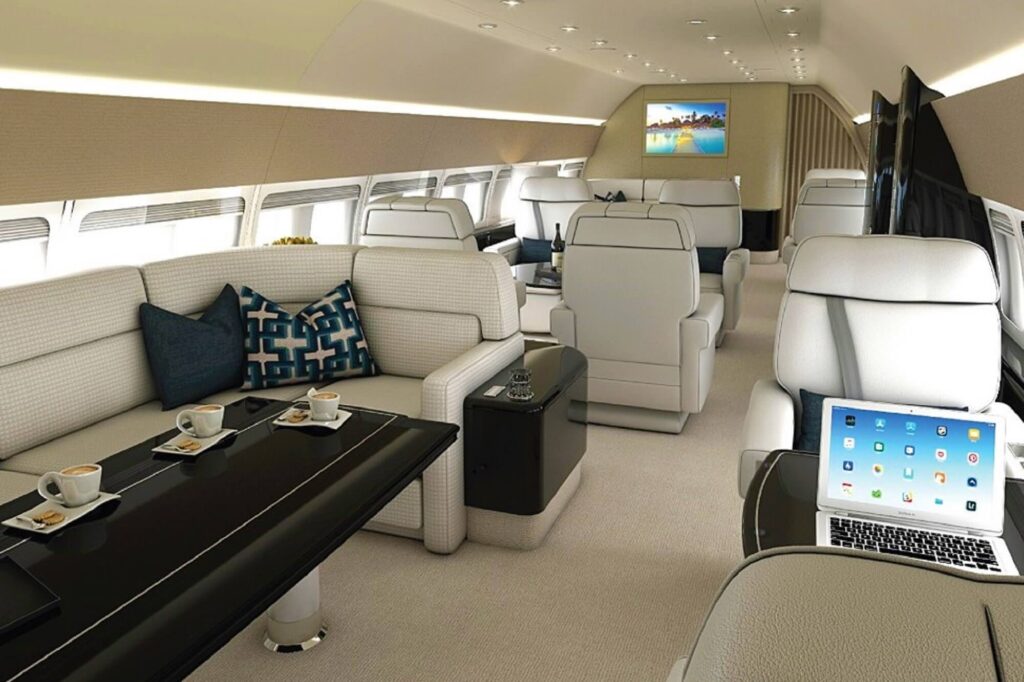The EU-based corporate charter and ACMI services provider KlasJet has expanded its executive aircraft fleet with a Boeing Business Jet 2 (BBJ2).
The jet, registered N371BC, is currently in the interior renewal process, which will make the plane capable of meeting the most sophisticated needs of VIP travelers.
According to KlasJet chief executive Rita Domkute, the 23-seat BBJ2 will feature a spacious lounge area as well as an on-board bedroom and a shower. “It is planned with convenience and comfort of passengers in mind, the design is created using high-quality materials,” the CEO said in the KlasJet statement released on November 24, 2022.
Set to launch operations in mid-April 2023, the uniquely designed BBJ2 will be “a splendid addition to KlasJet’s exclusive private aircraft fleet” as it is dedicated to meeting “the specific needs of high-ranking clients traveling in smaller groups,” the airline added.

The aircraft will offer a private business flight experience for affluent families, government representatives, presidents, and royal families as well as important business delegations.
“We plan that the newly added B737 BBJ2 will allow us to strengthen our positions in the rapidly growing Middle East market as the jet is a perfect option for high-ranking individuals who are living in or visiting the region on regular basis,” the KlasJet CEO added.
Once refurbishment of the aircraft interior is completed, the jet airliner will be based in Dubai, the UAE.
Designed for an exclusive in-flight experience
The Boeing Business Jets (BBJ) family consists of multiple versions of Boeing’s bizliners with are modified to serve the private, head of state, and corporate jet market.
Following the roll of the first BBJ, which was based on the Boeing 737-700 narrow-body in 1998, Boeing expanded the BBJ brand with various plane configurations based on the 737 MAX. These were the 777, the 777X, the 787 Dreamliner, and the 747-8 Intercontinental aircraft, which are now recognized as the BBJ 737 MAX family, BBJ 777s, BBJ 777Xs, BBJ 787s, and BBJ 747-8s, respectively.
Based on the Boeing 737-800, the first BBJ2 was introduced in 1999. The executive airliner is powered by two CFM56-7B27 turbofan engines and is equipped with wing tanks that hold 26,025 liters (around 6,875 gallons) of jet fuel. It can also feature between three and seven additional tanks, which bring the total fuel capacity to up to 39,531 liters (10,443 gallons).
The capacity of fuel tanks provides the jet with a long-range capability making it suitable for flying up to 5,500 nautical miles (10,186 kilometers) without a refueling stop. This means that the BBJ2 can serve direct non-stop flights between New York and London, London and Singapore, and Tokyo or Rio de Janeiro.
The airliner’s fuselage features aluminum alloy wings with blended winglets which reduce air turbulence, and increase fuel mileage, range, and altitude capabilities. To reduce aircraft weight, the manufacturer made its ailerons, elevators, and rudder from composite materials, including carbon-reinforced plastics, Kevlar, and graphite. Meanwhile, the design of the plane’s spoilers, airbrake panels, and the trailing edges of the slats and flaps include aluminum honeycomb sections.
To facilitate ground operations at airports with reduced ground support, the BBJ2 is also equipped with built-in airstairs.
Looking at cabin design, the aircraft boasts a passenger cabin area of more than 93 square meters (1,004 square feet), which is 25% larger when compared to BBJ1.
Although Boeing delivers all variants of BBJ family planes in a “green” condition without any interior furnishings, the jet can be equipped with personally designed bedrooms, living and dining rooms, two bathrooms, a conference area, and even a fitness center.
The interior configuration could typically include an executive office, conference rooms, private offices, and bedrooms.

